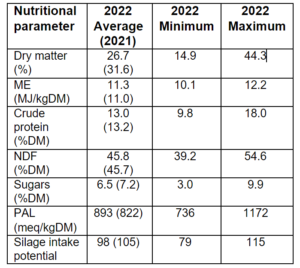Milk Manager News September 2022 – Silage Quality and Milking Performance
13 September 2022Results from SAC Consulting’s analytical laboratory indicate that first cut silages from dairy farms this year are on average wetter compared to last year’s average but with slightly higher metabolisable energy (ME) content.
This is a slightly different trend from the findings of Trouw Nutrition and their analysis of over 500 early cut dairy silages, which had higher NDF (neutral detergent fibre or total fibre content) and lower ME values (11.45 vs 11.71 MJ/kg DM) compared to silages in 2021. Silages with a lower ME and higher NDF this year are likely due to a higher proportion of overwintered grass in silage fields and those waiting for more bulk with slightly later cutting.
Results of 1st cut dairy silages
Source: SAC Consulting
Looking at SAC’s results in the above table, the variation between the minimum and maximum values is enormous, especially for dry matter and protein content. The 2.1 MJ difference between the lowest ME and highest ME silage equates to 4.75 litres of milk, based on a silage dry matter intake of 12kg. Higher protein silages will be best supplemented with feeds that supply more bypass protein such as protected sources of rapemeal or soya, as a high percentage of protein in silage is rapidly degradable in the rumen. These silages are likely very early cut, with low NDF values and will be best fed alongside some slightly more mature forages such as wholecrop and other fibre sources (soya hulls or sugar beet pulp) to ensure sufficient fibre for rumen health.
Given the average dry matter content there are obviously some wet silages around, which can bring several problems such as:
- Clamp slippage: spoilage of silage around the slippage area can reduce feed value and palatability and is more likely to cause heating in the TMR. It would be worth feeding a mycotoxin binder for a period of time until the silage quality improves.
- More risk of acidosis: wet silages tend to have a higher potential acid loading value. When combined with a high starchy diet/high concentrate intake, the risk of acidosis is increased.
- Low dry matter intake: partly due to lower bulk fill as well as reduced palatability with less sugars and higher levels of undesirable acids produced during fermentation, leading to lower milk output.
If available, mix in some drier forage; bales are ideal to provide some longer chop material to help dry up the mix and improve ration presentation and cudding rates. Baled silage or hay would be preferable, but if not available then straw at 0.5 to 1kg/cow will be beneficial to incorporate with very wet silages and provide more effective fibre for rumination. Chop length is important to ensure that cows cannot select out the longer fibre particles and leave them (no longer than 5cm). Addition of molasses will also help improve palatability and intakes.
On the other hand, dry silages can pose problems too in terms of keeping quality, TMR heating, ration sorting and lowered intakes. The addition of water to help bring the overall ration dry matter content to around 40% can help with intakes and reduce sorting behaviour.
If cows are not milking as well as you expect this winter, it is worth retesting the silage with a face sample. Do not just rely on the analysis of a core sample that was taken earlier in the summer, especially if that core sample was taken at a different point in the pit that you are currently feeding out of. If milk yield cannot be explained by the silage quality and ration formulation, other contributing factors could be:
- Issues with transition performance and increased incidence of metabolic diseases.
- Average days in milk – target is around 180 days for an all-year-round calving herd. Are there many later lactation cows with high days in milk dragging the average down as opposed to cows not milking to their potential? If cows are peaking where they should be and not losing excessive condition in early lactation, then this implies that nutrition should be adequate.
- Hangover effects of heat stress this summer. Reduced intakes, milk yield and fertility can still be evident six to eight weeks later.
- Low body condition score in early lactation or calving in too low a score, with cows lacking the energy reserves to milk as well off their backs in early lactation.
- Other disease issues – mastitis or metritis.
- Stocking density – is there sufficient feed and lying space for the number of cows?
- Lameness incidence.
lorna.macpherson@sac.co.uk; 07760 990901
Sign up to the FAS newsletter
Receive updates on news, events and publications from Scotland’s Farm Advisory Service

